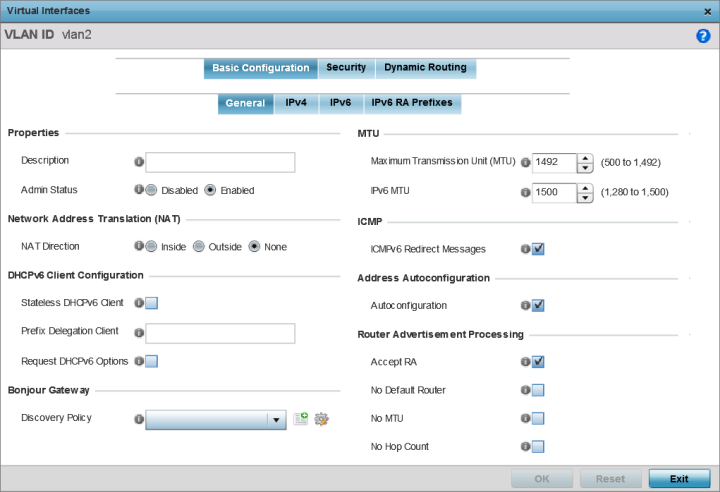Override OSPF VLAN General Settings
About this task
To add a new VLAN configuration or override an existing VLAN configuration:
Procedure
-
Select
Add or select the VLAN from those listed on the
screen and click Edit.
You can also delete existing configurations.The Basic Configuration screen displays, with the General tab selected by default.
 OSPF - VLAN Interface - Configuration Screen
OSPF - VLAN Interface - Configuration Screen
- If creating a new Virtual Interface, use the VLAN ID spinner control to define a numeric ID from 1 - 4094.
-
Define the following parameters
from within the Properties field:
Description Provide or edit a description (up to 64 characters) for the Virtual Interface that helps differentiate it from others with similar configurations. Admin Status Either select the Disabled or Enabled radio button to define this interface‘s current status within the network. When set to Enabled, the Virtual Interface is operational and available. The default value is Disabled. -
Define the Network Address Translation
(NAT) direction.
Select one the following options:
- Inside - The inside network is transmitting data over the network to its intended destination. On the way out, the source IP address is changed in the header and replaced by the (public) IP address.
- Outside - Packets passing through the NAT on the way back to the LAN are searched against the records kept by the NAT engine. There the destination IP address is changed back to the specific internal private class IP address in order to reach the LAN over the network.
- None - No NAT activity takes place. This is the default setting.
-
Set the following DHCPv6 Client
Configuration parameters:
The Dynamic Host Configuration Protocol for IPv6 (DHCPv6) provides a framework for passing configuration information.
Stateless DHCPv6 Client Select this option to request information from the DHCPv6 server using stateless DHCPv6. DHCPv6 is a networking protocol for configuring IPv6 hosts with IP addresses, IP prefixes or other configuration attributes required on an IPv6 network. This setting is disabled by default. Prefix Delegation Client Specify a 32 character maximum request prefix for prefix delegation from a DHCPv6 server over this virtual interface. Devices use prefixes to distinguish destinations that reside on-link from those reachable using a router. Request DHCPv6 Options Select this option to request DHCPv6 options on this virtual interface. DHCPv6 options provide configuration information for a node that must be booted using the network rather than locally. This setting is disabled by default. -
Set the following MTU
settings:
Maximum Transmission Unit (MTU) Set the PPPoE client MTU from 500 - 1,492. The MTU is the largest physical packet size in bytes a network can transmit. Any messages larger than the MTU are divided into smaller packets before being sent. A PPPoE client should be able to maintain its point-to-point connection for this defined MTU size. The default MTU is 1,492. IPv6 MTU Set an IPv6 MTU for this virtual interface from 1,280 - 1,500. A larger MTU provides greater efficiency because each packet carries more user data while protocol overheads, such as headers or underlying per-packet delays, remain fixed; the resulting higher efficiency means a slight improvement in bulk protocol throughput. A larger MTU results in the processing of fewer packets for the same amount of data. The default is 1,500. - Within the ICMP field, define whether ICMPv6 redirect messages are sent. Redirect requests data packets be sent on an alternative route. This setting is enabled by default.
- Within the Address Autoconfiguration field, define whether to configure IPv6 addresses on this virtual interface based on the prefixes received in router advertisement messages. Router advertisements contain prefixes used for link determination, address configuration and maximum hop limits. This setting is enabled by default.
-
Set the following Router Advertisement
Processingsettings for the virtual interface. Router
advertisements are periodically sent to hosts or sent in response to
solicitation requests. The advertisement includes IPv6 prefixes and other subnet
and host information.
Accept RA Enable this option to allow router advertisements over this virtual interface. IPv6 hosts can configure themselves automatically when connected to an IPv6 network using the neighbor discovery protocol via ICMPv6 router discovery messages. When first connected to a network, a host sends a link-local router solicitation multicast request for its configuration parameters; routers respond to such a request with a router advertisement packet that contains Internet layer configuration parameters. This setting is enabled by default. No Default Router Select this option to consider routers unavailable on this interface for default router selection. This setting is disabled by default. No MTU Select this option to not use the existing MTU setting for router advertisements on this virtual interface. If the value is set to zero no MTU options are sent. This setting is disabled by default. No Hop Count Select this option to not use the hop count advertisement setting for router advertisements on this virtual interface. This setting is disabled by default. - Use the Discovery Policy drop-down menu to define the Bonjour Gateway Discovery Policy. Bonjour is Apple‘s service discovery protocol.
-
Select OK to save the
changes.
Select Reset to revert to the last saved configuration.
